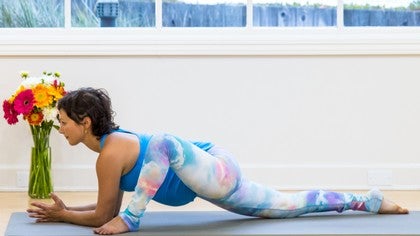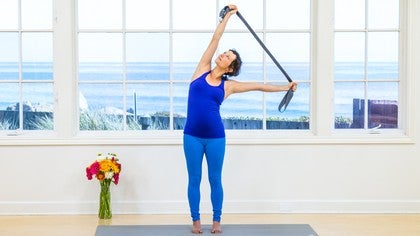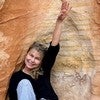Description
About This Video
Transcript
Read Full Transcript
Hi again yogis, welcome back. The focus of the practice today is going to be checking in or attuning with yourself. And I think as long time practitioners we get really good at doing this, but when we start and maybe some cultural influence as well, we don't always check in with ourselves. So I'm really happy to share that with you today in preparation for a meditation. And we're going to be doing a really sweet hip opening practice to help us sit with a little bit more ease, working towards a slightly longer sit today.
So of course you'll need something underneath your hips just for a few short moments and for the end of the practice, blanket, two blankets, pillow, whatever you got, maybe a bolster. And it'll be useful to have two thick blocks as well to support you for the practice. So comfortable cross legged, kneeling, kick one leg out, whatever works, and sit up nice and tall, supporting yourself from your spinal line and relaxing your shoulders on the length of that spinal line. Few grounding breaths. I always like to close my eyes, check in if you like that, or one pointed focus on the floor in front of you.
Inhale, gather your attention. And exhale, ground down into your hips, into your legs, into your connection with the earth. Exhale, start to really feel yourself here, and exhale ground into your experience of the body. And just here, really check in feelings, sensations, emotions. Whatever you seeing, sensing, learning, just really checking in.
We'll come back to this at the end of the practice. So big inhale into the sides of your lungs, and exhale, let your chin drop down towards your chest. We're gonna let her right ear come over her right shoulder, and a few deep breaths. You can even let your left arm float up, and you can play with flipping your left palm up and flipping it down as you breathe into this next stretch. Let that hand come down, chin rolls into the center, over to the other side.
And if you wanna play with right arm elevating, and playing with an internal spiral, and external spiral of that whole arm, getting into different parts of the neck. We hold so much in our necks, in our musculature, connecting our head to our torso, our mind to our heart. Let that arm come down, and let's play with a few circles. So we're gonna lift the chest as we go back, maybe not going back so far, chin rolls in towards the chest, and then switching directions of those big neck circles. I like to inhale as I open up and look up, exhale as I come down, letting the head roll back up.
And let's let our left leg kick forward, so I'm just gonna turn this way to show you, or actually our right leg, sorry, right leg forwards. Left leg comes in at a nice wide angle. Left arm back behind you, right arm up, and then exhale, bring that right arm on the inside of your right leg, and you can let your left arm sweep straight up, hold your head if you have neck tension, or reach out and over into a nice side bend. So as you can see here, the angle of my left knee is a little bit wide. Three deep breaths, two, and three.
Use your top arm to help you come all the way up, and then shift your hips so they're not so open, they're facing forwards a little bit more. Walk your buttocks bones back, and come forwards in a forward fold. Janu Shoshasana, three deep breaths. And so some people can come way forwards in this pose, some people want to stay nice and upright, and if you want more out of your calf, flex your right heel forwards. Two more deep breaths.
One. And two. And then inhale your way up, and we're going to hook our left ankle on top of our right knee, not right on the knee, but on top, hands back behind you, and bend our right foot so that it comes in. The more you walk your hands in, the more sensation you'll probably get in the outer left hip. And see if you can bring your shin and your chest closer together, if it's too much sensation, walk it out.
Two more nice deep breaths here. And as you can see, I'm up on the ridge tops of my fingers, it's giving me a little bit more lift through my spine, and I'm flexing my left foot. I'm going to walk that forwards. If you have tweaky wrists, fingers point back behind you. If not, you can turn the fingers in towards you.
First option, roll open the chest, look up, elbows squeezed together. Second option, for three deep breaths, lift your hips. Keeping your hips level to the floor, maybe letting your head go back. If you have neck tension, or whiplash, or anything like that, you might want to look forwards here, hips a little bit higher, and one more nice deep breath. And exhale, letting it come down, and reaching your legs out.
Releasing your wrists, so we're going to have our left leg forwards, take that right leg really wide, so we're facing out on a diagonal, right arm behind, inhale your left arm up. Inhale on the inside of the leg, right arm up, hold the head, or reach out and over. One, breathe deep into those bottom lungs. Two, and three, bring it all the way up, we're going to square our hips more forwards. Right knee comes forwards, buttock bones back, deep inhalation to open the belly and the chest, and exhale, three deep breaths, Janu Shishasana.
You can use your hands for support. If you want to make it more challenging, hold onto your foot. More challenging still, pull your toes back, flex your heel forwards. Two more breaths, one, two, inhale your way up, exhale, release. Right ankle on top of the left knee, not on the knee, bending that in, I'm going to walk up onto the ridges of my fingers, ease it up if you want to, pull it in if you want to, chest towards the shin, one, flex the foot, shoulders back gently, two, and three.
Forewards with the left foot, choose your hand position, fingers in if you don't have wrist stuff, fingers out if you do, hips forwards, roll shoulders up, back and down, use the shoulder blades gently, press into the back of the chest, option one, option two, lift the hips, maybe slide the shoulder blades back, let the head go back, one, hips higher, two, press into your fingertips, and three, let those hips come down, release your legs, passing at your shins, roll over and into a downward facing dog, and puddle out your feet, downward dog one, lift your armpits, bring your ribs in and stretch your arms more towards straight, you also can bend your knees if you're feeling really tight in your hamstrings, three deep breaths, and we've already had one, let your head go, two, three, downward dog two, walk your feet the width of your mat, pigeon toes slightly, bend your knees, and let your armpits and chest drop towards the floor, maybe your head even touches the floor, two, three, lift your armpits, feet come back together, inhale your right leg up, come high up onto your left toes, and on your exhale, knee towards your nose and right foot forwards, so you might need to grab it and move it forwards, and you might also use your blocks here on either side of your foot to give you a little bit of a lift, three deep breaths here, strengthen the back leg, preparing to climb up out of your lunge, so legs are strong, spine is soft, jaw is soft, eyes are soft, feel the steadiness of your legs and on your inhalation, come on up, and let your arms reach up, open your hand bones, see if you can lift some space in your wrist joints, and really feel soft in the front of your spine, strong and open in your back muscles, grounded in your feet, one more nice deep breath, we're going to bring our arms forwards and on the inside of our right foot, so we're going to toe heal that right foot out to the side, and you can be on your blocks or hands on the floor, and let your back knee drop, so if you have knee issues keep the toe tucked under, if not you can let the top of the foot come to the floor and press into the toenails of your left foot, let your hips sink forwards, and I'm going to feel really good for me right now to come on right onto my hands, you have a couple of options here, you can be down on your hands, you can come down onto your forearms even, or you can even put your forearms on your block, if you're really rounded in your upper back, see if you can soften that upper back, right in between the shoulder blades, for some people also we'll be here for a couple more breaths, it feels useful to turn your right toe and right knee out to the side, ease into those hips by a little bit of wiggling to soothe the nervous system and the pose, and then let's be really steady for one more deep breath, okay we're going to let the hips lift and sink the hips back a little bit, and see if we can aim our head towards the floor any amount, or aim our head towards our ankle, three deep breaths, and some of us can even thread our right arm under to hold onto the foot and take the head towards the ankle, then we're going to come up, get out of there and wiggle our front leg into a pigeon pose, so the knee comes towards the wrist, tuck the back toes, inch the hips back, and come down onto our forearms, so some people want to put a block or a bolster underneath your right hip, if the hip is really elevated, and I want to show one more option here because we're going to be here for about five breaths or so, but if it doesn't feel good on your knee or your ankle or your hip, you can always swing all the way around, roll onto your back, put your ankle in front of your knee and take this kind of figure four, I've had some students with hip replacements and they really prefer this option, but for me right now, this shape is feeling really good, so you can lean side to side, sink into it, I like to tuck the back toes under and press through the back inner heel, it gives me more energy in that back leg, exposes my hip more to me, and let's do pigeon two and pigeon three, so we'll do a little walk of our heart over the right knee and have a little side bend here, and then we're going to walk our heart over towards the right foot on a diagonal, then let's come back to the center, and we're going to lift up and roll onto the inner edge of our back leg like that, so we're really rolling onto our right sit bone, and then see if it's possible to widen the angle of our right leg, and then lean in hard on a diagonal, for some people this is a much easier way to get their front shin at a 90 degree angle with this back leg turned out, one more nice deep breath, before we come into downward dog, I'm really going to close my calf and hamstring together, shift forwards and paddle it back into a downward dog, beautiful, and before sides there I'm going to come down onto my knees, keep my hips over my knees, walk my hands way forwards and let my head come down, armpits and chest gently sink to the floor, energize your arms, really touch in with softening your jaw, softening your palate, doming your palate towards the center of your skull, some people even like to look up and take their chin to the floor, lift the armpits, walk our hands back in, tuck our toes back into downward dog, feet together at the back of the mat, inhale your left leg up, you can come high up onto your right toes, exhale knee to nose, and foot forwards for your lunge, here you might want your blocks again so I'll just show that they can always be on either side of the front of the mat, three deep breaths energizing your legs ready to come up, it's almost like you want to lighten your hands on the floor, so you start to feel that softness through your horizontal line of your arms and the strength through the vertical line of your spine reaching forwards, we're going to climb up out of that lunge, reach the arms up and breathe there, three deep breaths, strong and steady legs, you might even pulse down and up in your legs a little bit and then feel the lift from your pelvic floor right up into the crown of your head, exhale your hands come down, heel toe, your left foot out to the side, maybe out on an angle, your blocks are your fingers on the inside and drop that knee down, I'm going to move the blocks out to the sides because I like to be right down on my hands and easing into the hips, slow deep breathing, you can untuck the back toe if you like, you can come down onto your elbows if you like, sometimes it's nice to lean a little side to side, so we're going to tip our hips back a bit and when I do that I'm going to want to point my left toes more forwards and just shift a little bit forwards and back and then I walk my hands a little bit over to the right and aim my head towards the floor, so I might just bend a little bit and check that out, I might tuck my back toes under for more stability, I might even take my left arm under to hold onto my foot, brace myself with my right hand and aim my head towards my ankle, soften your jaw on the intensity of this stretch, two more deep breaths, feeling your body in space, feeling where you need to back off, where you need to drop in, inhale your way up, ease that front leg into pigeon, so the knee towards the left wrist, walk the hips back and start to come down onto your forearms, put something underneath your hips if you want, you can energise your back leg by pressing through your back toes and notice if you're rounding in the upper back and see if you can really soften in the upper back, also sense the back of your pelvis, that sacrum bone right in between the two wings of your pelvis, can you allow that to shift in to the pelvis instead of feeling like you're rounding and engaging your abdomen and rounding the back of the pelvis, let everything spine, sacrum sink in and ooze forwards, even if you're just imagining that happening. Let's walk ourselves if you like, heart over the knee, couple of breaths, let that deep slow breathing prepare you for sitting, walk over to the other side, lean in. One of those variations or start to roll onto the back of your left buttock and come onto the inner right foot and maybe open this up a little bit, you might even put padding under your knee, so you're more of a 90 degree or maybe even a little bit more of an obtuse angle, and then lean in, really let your right hip open up, it's really asymmetrical and of course some people can come a little bit lower here, inhale come on up and we're going to close this quite a bit before we roll back, navel towards the floor and step it back into a dog pose and walk out those new hips and legs that you have. You can twist out your dog, spinning and revolving your torso one way and the other, and again come down onto the knees, walk the hands way forwards and allow the upper back to melt. Chest armpits, gently releasing down, really lift your armpits here and walk your way back into a child's pose.
I'm going to put my knees really wide to make space for my baby but you can bring them right together if that feels better, and I'm going to go diamond shape with my elbows wide and my hands together to really lean into the elbows to really feel a softness happening at the back of the neck, and we're preparing for lying down on our back here, hips heavy towards the heels, roll on up and pick your favorite way to get onto your back, roll onto our back, bring our knees in and hook your right ankle on top of your left knee, draw the whole unit of that in towards you. For some people who feel really tensionally tight in the hips, it might be useful to put a blanket or a block under your head, it will ease it up a little bit. Thread your hands through to hold on under your hamstring or if you have long arms like me, hold on on top of your shin, draw it in. You can use a little resistance here by flexing your feet and kind of pushing your right shin away from you as you draw the whole unit in, it will be a stronger stretch. Either stay there for three more breaths or take both hands on your flexed foot, draw it in towards you and let your left leg come towards the floor and breathe.
What you can play with here is letting the knee come up to the side and just bringing your head using a little abdominal strength to bring your head towards your foot. Like that, maybe a little short, sweet visit or maybe you stay for a couple of breaths, you can also rock into that hip. And then we're going to easy let that go, feet nice and wide, distance of the mat and just rocking side to side on the back of the pelvis, arms can come over the head. I'm doing like really subtle wind-filled wipers, feeling one side of the pelvis and then the other and switching sides, so we're going to hook that ankle, you might choose to put something under the back of your hub and actually for me that feels really good right now because I don't have to use my abdominals as much. Soothing by rocking and then maybe a little bit of stillness, pushing the left leg away, drawing the whole unit in towards you, exposing that left hip.
Different with pulling with the back muscles instead of the chest muscles. Maybe you hold on to that flex foot, draw it out to the side a bit, draw it in towards you, ground the right leg. And of course for more, you can straighten this leg. This feels good for me right now. If you want to, you can bring your head up for a moment or maybe for a few deep breaths.
Sometimes doing something a little bit intense, like more intense than your thoughts is useful when you're going into a little meditation, just to clear space. I'm going to let that go. Sometimes comfortable, feet wide, tiny little windshield wipers side to side. Knees in towards the chest and we're going to roll over onto one side. Come on up and prepare for our meditation.
So I'm going to grab my blanket, sit comfortable, belly soft, belly dropped, a few shoulder rolls just to remind me not to let the pectorals harden and collapse my chest. So not militant in lifting the chest, but soft and wide through the upper back. Hands find a position that's comfortable and a few grounding breaths. Noticing how you feel here. Sometimes we only have a few minutes in our day.
Can we really intelligently use this time to check in, attune to ourself, attune to sensations in the body, what we're learning about ourselves, what works and doesn't work. And when we check in deeply to how we feel, can we stay grounded in that and then open up our awareness to the space around us? Amazing sound, feeling of the space around you. And imagine you were interacting with somebody else that you really wanted to support 50% of your awareness is in how you feel in grounding yourself and 50% is turning that outward and being with the other person. So you're continually coming back to knowing your own space to grounding yourself and then continually being with other.
And this practice is super useful if you're a caretaker or in a field of work where you're taking care of others a lot and you get fatigued. If you're a parent, if you're a lover, it's called the 50-50 practice. Scanning your body and allowing tension to dissolve with your exhalation. And letting the process of relaxation take over your assumptions and expectations. Awesome.
Thank you. And just allow a few deeper breaths to come into the back of the lungs, into the bottom of the lungs. Feeling I'm grateful, I'm alive. Your chin drops down towards your chest, letting the eyes open. And if you like, your hands can come together at your heart, acknowledging the work that you did today.
Thank you. Namaste.
Move to Meditate: Lydia Zamorano
Comments
You need to be a subscriber to post a comment.
Please Log In or Create an Account to start your free trial.






















